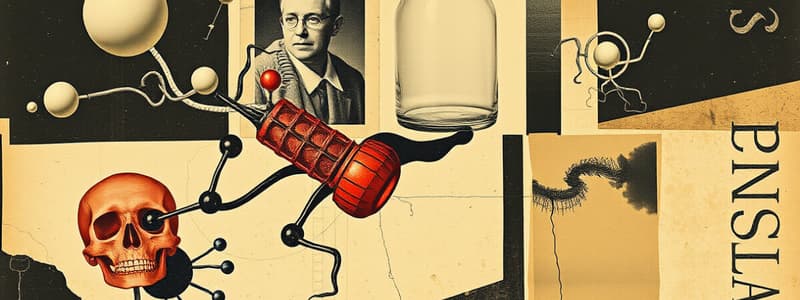Podcast
Questions and Answers
What effect does selectivity have on the curves representing drug binding to receptor subtypes?
What effect does selectivity have on the curves representing drug binding to receptor subtypes?
- Curves show no difference between selective and non-selective drugs.
- Curves appear extended on the x-axis and the flexing point is shallower. (correct)
- Curves shift to the left, indicating higher binding affinity.
- Curves become steeper and narrower on the x-axis.
What occurs when a non-selective drug binds to receptor subtypes?
What occurs when a non-selective drug binds to receptor subtypes?
- The drug shows higher selectivity for one receptor subtype.
- Curves representing binding affinity become steeper. (correct)
- Curves will appear as a single linear graph.
- The Scatchard graph remains linear.
What does a Hill coefficient (n) of 1 indicate regarding cooperativity at the binding site?
What does a Hill coefficient (n) of 1 indicate regarding cooperativity at the binding site?
- There is strong positive cooperativity between multiple binding sites.
- Only one binding site is present, with no cooperativity. (correct)
- There is a linear relationship between binding sites.
- Two or more binding sites are exhibiting negative cooperativity.
How does the interaction of selective drugs with multiple receptor subtypes change at higher concentrations?
How does the interaction of selective drugs with multiple receptor subtypes change at higher concentrations?
Who discovered the Hill plot and what was it studying?
Who discovered the Hill plot and what was it studying?
In a situation where a drug exhibits positive cooperativity, what would the Hill coefficient value likely be?
In a situation where a drug exhibits positive cooperativity, what would the Hill coefficient value likely be?
What does a non-linear Scatchard graph indicate about a drug's binding characteristics?
What does a non-linear Scatchard graph indicate about a drug's binding characteristics?
What is the general consequence of increased receptor selectivity for drug binding curves?
What is the general consequence of increased receptor selectivity for drug binding curves?
What does the binding behavior of a selective drug imply about its graph representation on the x-axis?
What does the binding behavior of a selective drug imply about its graph representation on the x-axis?
What happens to the flexing point of curves when drugs possess selectivity among receptor subtypes?
What happens to the flexing point of curves when drugs possess selectivity among receptor subtypes?
A selective drug binds to multiple receptor subtypes with the same affinity.
A selective drug binds to multiple receptor subtypes with the same affinity.
The presence of multiple receptor subtypes causes the curves for selective drugs to look steeper.
The presence of multiple receptor subtypes causes the curves for selective drugs to look steeper.
A non-selective drug will yield a linear Scatchard graph.
A non-selective drug will yield a linear Scatchard graph.
The Hill coefficient can be equal to or greater than the number of available binding sites.
The Hill coefficient can be equal to or greater than the number of available binding sites.
In a scenario where N=1 in the Hill plot, there is a presence of positive cooperativity.
In a scenario where N=1 in the Hill plot, there is a presence of positive cooperativity.
Cooperativity increases when the Hill coefficient (n) has a value greater than 1.
Cooperativity increases when the Hill coefficient (n) has a value greater than 1.
At higher concentrations, selective drugs can interact with additional receptor subtypes.
At higher concentrations, selective drugs can interact with additional receptor subtypes.
The more selective a drug is, the more extended the binding curves are on the x-axis.
The more selective a drug is, the more extended the binding curves are on the x-axis.
The discovery of the Hill plot was unrelated to the binding of hemoglobin to oxygen.
The discovery of the Hill plot was unrelated to the binding of hemoglobin to oxygen.
Both selective and non-selective drugs can impact the shapes of their binding curves identically.
Both selective and non-selective drugs can impact the shapes of their binding curves identically.
Flashcards are hidden until you start studying
Study Notes
Selectivity of Drugs
- Selective drugs target specific receptor subtypes, enhancing their interaction with a particular receptor.
- These drugs produce extended curves on the x-axis in graphical representations, indicating a broader interaction range.
- The flexing point in the curve for selective drugs is shallower, reflecting interactions with additional receptor subtypes.
- Non-selective drugs bind to various receptor subtypes with equal affinity, resulting in unchanged graphical curves that are steeper.
- The Scatchard plot for non-selective drugs is nonlinear, representing a composite of two linear relationships: one for high-affinity binding and one for low-affinity binding.
Interpretation of Selectivity
- Selective drugs predominantly interact with specific receptors; thus, their graphical representation is flatter and shallower.
- At elevated concentrations, selective drugs can also bind to other receptor subtypes.
Hill Plot and Cooperativity
- The Hill plot illustrates cooperativity within binding sites on macromolecules, originating from hemoglobin's oxygen binding study.
- The Hill coefficient (n) quantifies the degree of cooperativity; it can take any positive value, limited to the number of binding sites present.
- If n equals 1, there is no cooperativity, indicating a single binding site.
- Values of n greater than 1 signify positive cooperativity, suggesting interactions between multiple binding sites.
Selectivity of Drugs
- Selective drugs target specific receptor subtypes, enhancing their interaction with a particular receptor.
- These drugs produce extended curves on the x-axis in graphical representations, indicating a broader interaction range.
- The flexing point in the curve for selective drugs is shallower, reflecting interactions with additional receptor subtypes.
- Non-selective drugs bind to various receptor subtypes with equal affinity, resulting in unchanged graphical curves that are steeper.
- The Scatchard plot for non-selective drugs is nonlinear, representing a composite of two linear relationships: one for high-affinity binding and one for low-affinity binding.
Interpretation of Selectivity
- Selective drugs predominantly interact with specific receptors; thus, their graphical representation is flatter and shallower.
- At elevated concentrations, selective drugs can also bind to other receptor subtypes.
Hill Plot and Cooperativity
- The Hill plot illustrates cooperativity within binding sites on macromolecules, originating from hemoglobin's oxygen binding study.
- The Hill coefficient (n) quantifies the degree of cooperativity; it can take any positive value, limited to the number of binding sites present.
- If n equals 1, there is no cooperativity, indicating a single binding site.
- Values of n greater than 1 signify positive cooperativity, suggesting interactions between multiple binding sites.
Studying That Suits You
Use AI to generate personalized quizzes and flashcards to suit your learning preferences.



